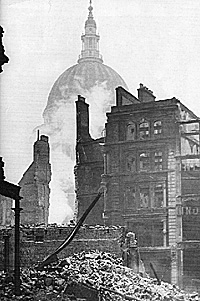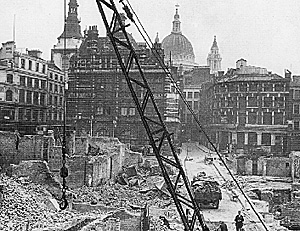 Longmans had been in Paternoster Row since 1724. In the early part of the winter of
1940 they divided their stock between the Row and a warehouse in Bermondsey. By
a strange quirk of fate in this one evening both warehouses were completely
destroyed. Over three million books were in the two buildings. At 39 Paternoster
Row, only Longmans safes and strong room remained. When opened 19 days later
the papers in the safes were found to have been charred out of all recognition but the
contents of the strong room were intact. Out of their stock of 5,000 titles available
before Christmas now 12 could be supplied – and these only because they were at the
binders.
Longmans had been in Paternoster Row since 1724. In the early part of the winter of
1940 they divided their stock between the Row and a warehouse in Bermondsey. By
a strange quirk of fate in this one evening both warehouses were completely
destroyed. Over three million books were in the two buildings. At 39 Paternoster
Row, only Longmans safes and strong room remained. When opened 19 days later
the papers in the safes were found to have been charred out of all recognition but the
contents of the strong room were intact. Out of their stock of 5,000 titles available
before Christmas now 12 could be supplied – and these only because they were at the
binders.
Blackwood’s office had been at the corner of the Row since 1845. All that was rescued from the charred remains were an office safe and two fire- blackened brass number plates from the main doors. Ward Lock, in Warwick House, had already been hit by two bombs on the previous Friday. Then their warehouse was badly damaged. Now their building was completely destroyed. The firm was homeless until they were offered temporary accommodation in Unilever House on the Embankment.
As Collins’ warehouse in Bridewell Place was burnt out the staff were offered the option of leaving for a less vulnerable area or removing to Glasgow. They voted to stay in Central London and moved to their new premises at Bow Street. The tall Whitaker building in Ave Maria Lane, from which The Bookseller had been published for more than three- quarters of a century, was gutted. The Bookseller appeared, as Sir Geoffrey Faber, then President of the Publishers Association, wrote in the Author, “without a hair out of place”, as usual the next Thursday, January 2nd. Stationers’ Hall had been damaged in a previous raid and was now hit again. The Publishers Association in the basement had to abandon their offices.
In Warwick Square, Hodder & Stoughton suffered a direct hit and their stock was damaged by water yet, also in the square, the Oxford University Press were probably the only publishing house in the area to emerge unscathed. Cassell’s own roof- spotters dealt with one incendiary bomb in their Belle Sauvage building. The building survived for five months until May 1941, when it was completely destroyed.
The destruction of Simpkin Marshall, the largest distributing house in the trade, was perhaps the most staggering blow of all. They lost some six million books.
On Sunday December 29th 1940, 163 people were killed, 509 seriously injured. Guy’s Hospital had to be evacuated, 8 other hospitals were damaged. Five railway termini and 16 underground stations were closed. Guildhall was severely damaged. Eight Wren churches were destroyed, but St Paul’s miraculously survived the confla- gration although 28 incendiaries landed on the Cathedral.
 The next day Douglas Blackwood was on dawn patrol with RAF. Later to be head of
William Blackwood, he was then, at 31 years of age, in command of the first Czech
Fighter Squadron. From his plane at 25,000 feet over the North Weald he could see
the thick smoke from the burning City drifting slowly to the east.
The next day Douglas Blackwood was on dawn patrol with RAF. Later to be head of
William Blackwood, he was then, at 31 years of age, in command of the first Czech
Fighter Squadron. From his plane at 25,000 feet over the North Weald he could see
the thick smoke from the burning City drifting slowly to the east.
On December 31st Herbert Morrison, Home Secretary and Minister of Home Security, announced that fire- watching was to be made compulsory for all business premises.
The fires the Germans started continued to smoulder throughout the following week.
The weather turned colder on Thursday and water still being pumped on to the ruins and glowing cellars began to freeze in the roads and gutters. On Friday morning, January 3rd, the first snow of the winter fell.
Hubert Wilson, in his weekly column under the name of “Petrel” in The Bookseller of January 2nd 1941 said: “It is the even of the new year – and the hub of the English book trade lies in smoking ruins. Such a scene of destruction I have never seen or imagined … As I picked my way gingerly across from brick to brick, hot gouts of sulphurous fumes from buried fires seeped up between my feet; desultory flames played in the remains of a rafter here or a floor joist there, and on either side the smoking causeway fell sharply away into cavernous glowing holes, once basements full of the City’s book world. I looked around me in what was Paternoster Square and recognised nothing but a pillar box, the top beneath my feet: there was nothing left to recognise. Here and there half a wall still stood in dangerous solitude, two or three stories high, giving form and significance to the desolation, and that was all. I was quite alone (for I had found my way in through a passage unsuspected by the police) and no living thing was to be seen.”
The official Air Ministry description of the raid said, “there was nowhere any attempt to single out targets of military importance”.
One of my earliest memories of the war is of seeing the night sky over London red with the light of flames. I may have been watching the fire of Paternoster Row but I do not know, for in December 1940 I was only three years old.
Thanks go to Alfred Price for providing the technical aviation details.
Back to Greenhill Military Book News No. 126 Table of Contents
Back to Greenhill Military Book News List of Issues
Back to Master Magazine List
© Copyright 2003 by Greenhill Books
This article appears in MagWeb (Magazine Web) on the Internet World Wide Web.
Other articles from military history and related magazines are available at http://www.magweb.com